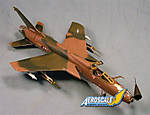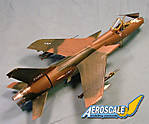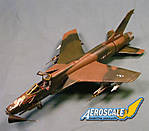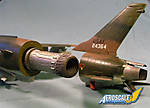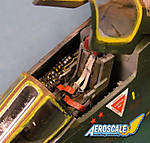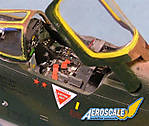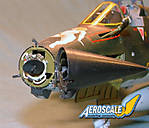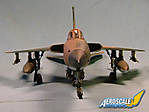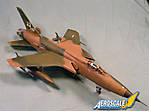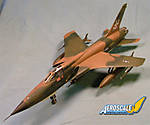1⁄48Century Series Pt.6 - F-105 Thunderchief
4
Comments
The jet age is epitomized by the legendary Century series of fighters.
The Century series aircraft, were tasked with defending the American homeland from the Soviet forces at the height of the Cold War, fighting a tenacious enemy over Vietnam and were also the backbone of Nato's nuclear strike force. They have been used as interceptors, bombers, reconnaissance and in nearly every conceivable role in between.
Republic Aviation started the Thunderchief as an internal project to replace the F-84F Thunderflash. The design team led by Alexander Kartveli examined some 108 configurations before settling on a large, single-engine AP-63FBX (Advanced Project 63 Fighter Bomber, Experimental) - AP-63-31 actual. The new aircraft was intended primarily for supersonic, low altitude penetration into the Soviet Union on a hi-lo-hi mission and delivery of a single, internally carried nuclear bomb. Thus, with emphasis placed on low-altitude speed and flight characteristics, range and payload, the aircraft would be fitted with a large engine, and a relatively small wing with a high wing loading which would give a stable ride at low altitudes, and less drag at supersonic speeds.
Traditional fighter attributes such as maneuverability were a secondary consideration. Enthusiastic at first, the United States Air Force awarded Republic with a contract for 199 aircraft in September 1952. However, by March 1953 the USAF had reduced the order to 37 fighter-bombers and 9 tactical reconnaissance aircraft, citing the approaching end of the Korean War. By the time the F-105 mock-up had been completed in October 1953, the aircraft had grown so large that the Allison J71 turbojet intended for it was abandoned in favor of an even more powerful Pratt & Whitney J75. Anticipating protracted development of the engine, it was expected that the first aircraft would use the smaller Pratt & Whitney J57. On 28 June 1954, the USAF officially ordered 15 F-105As under the Weapon System designation WS-306A.
The F-105 was a mid-wing monoplane with a 45 degree swept wing and tail surfaces. The single engine was fed by two intakes in the wing roots, leaving the nose free for a radome housing the multi-mode radar. At the time, the F-105 was the largest single-seat combat aircraft ever built. Its capacious fuselage provided room for 1,160 US gallons (4,460 L) of fuel and a bomb bay measuring 15 feet 10 inches by 32 inches by 32 inches (4.82 m x 0.81 m x 0.81 m), originally intended for a single nuclear weapon but typically containing an additional 390 US gallon (1,500 L) fuel tank. Two under-wing and one fuselage wet-stores-capable pylons were provided for 450 and 650 US gallon (1,730 L and 2,500 L) expendable fuel tanks. Two outboard (dry) stations were wired for missiles or bombs. A single T-171E3 20 millimeter Gatling cannon was installed in the left side of the nose with a magazine for 1,028 rounds of ammunition, combined with a radar ranging gun-sight in B and D models. The aircraft was designed to carry the short-range Sidewinder but it would not be equipped with the medium-range radar-guided missiles.
On 11 December 1959, an F-105B piloted by Brig Gen Joseph Moore (commander of the 4th Tactical Fighter Wing) set a world record of 1,216.48 mph (1,958.53 km/h) over a 100 kilometer (62 mi) circuit. Moore received the Bendix Trophy in 1959 for this feat. Plans to build over 1,500 F-105D's were cut short when the Secretary of Defense Robert McNamara decided to equip no more than seven combat wings with the type. Production was cut in favor of the Air Force adopting the Navy's F-4 Phantom II. A total of 833 F-105s were produced before production ended in 1964.
The F-105 was designed primarily for low-level interdiction and its low-altitude speed was its greatest asset when dealing with Soviet Mikoyan-Gurevich MiG-17 and Mikoyan-Gurevich MiG-21 fighters. The Thunderchiefs highly loaded wing was excellent for speed and smooth ride but not for sustained turns in a dogfight. Nevertheless, the F-105 managed 27.5 officially credited air-to-air victories against North Vietnamese aircraft at the cost of 17 aircraft lost to enemy fighters (North Vietnamese pilots claimed to have shot down an additional 23 F-105s but none have been confirmed by USAF). All victories were against MiG-17s -- 24.5 were shot down with cannon fire (one victory was shared with an F-4), and three with AIM-9 Sidewinder missiles. F-4 Phantoms were tasked to protect the Thuds from MiG fighters, but they lacked the internal gun and ranging gun-sight of the Thunderchief until late in the war.
On the basis of combat experience, the F-105D was updated with a better ejection seat, radar homing and warning (RHAW) antenna on the tail fin, additional armor, and protection to the hydraulic system which proved to be very vulnerable to combat damage. The hot and humid climate of Southeast Asia created problems for the capricious electronics, a problem encountered by virtually all advanced US aircraft of the war. High ambient temperatures also exacerbated the F-105's propensity for engine fires due to inadequate cooling of the afterburner. Most of the Vietnam aircraft were eventually fitted with ram-air scoops to ameliorate this problem.
Unfortunately, the low-altitude attacks and dive bombing brought the F-105s into the range of North Vietnamese anti-aircraft fire; the loss rates were so high that the USAF began experiencing shortages of combat-ready aircraft. A total of 382 aircraft were lost in Southeast Asia, 320 of those in combat. The vast majority of losses were the result of enemy ground fire. Of the 610 single-seat F-105D's built, 283 were shot down and 52 lost operationally. Of the 143 F-105F/G two-seaters, 37 were shot down and ten lost operationally (one "Ryan's Raiders" night interdiction aircraft and one Combat Martin jammer without a back-seat WSO were lost in combat, the other 45 losses were Wild Weasel aircraft).
YF-105B - Four pre-production aircraft.
F-105B - Initial production model; 75 built.
JF-105B - Test aircraft re-built from RF-105B airframes; 3 converted
RF-105B - Proposed reconnaissance version of the F-105B; none built.
F-105C - Proposed dual-control trainer; cancelled in 1957, none built
F-105D - The definitive production model, all-weather capability thanks to advanced avionics, first flight 9 June 1959; 610 built.
RF-105D - Proposed reconnaissance version of the F-105D; none built.
F-105E - Proposed trainer version of F-105D; cancelled in 1959, none completed
F-105F - Two-seat trainer version of F-105D, fully combat-capable, first flight 11 June 1963; 143 built.
EF-105F - Initial SEAD/Wild Weasel version; 86 built.
F-105G - Two-seat Wild Weasel SEAD version, 61 converted from EF-105F and F-105F.
Tail code "24364" - 1/48th Hobby Boss F-105D. Built mainly OOB with harness's added to the ejection seat and some wiring added to the undercarriage, gun bay and radar. Painted with Tamiya acrylics. Markings are for "Miss Galore" of the 354th TFS, 354th TFW.
Republic F-105 Thunderchief
The final member of Republics "Thunder" family, the F-105 Thunderchief was conceived to deliver a nuclear weapon against a point target while flying at supersonic speed at low level. Powered by the largest jet engine then available, the "Thud" as it became mockingly known, was plagued with early problems, but as the bugs were ironed out the largest single engined jet yet built became embroiled in a entirely different conflict and its reputation became legendary. Flying more missions then any other type of aircraft over the jungles of Indo-China, the F-105 formed the backbone of the Rolling Thunder bombing campaign against North Vietnamese targets between 1965 and 1968, and later pioneered USAF defence suppression techniques in the ground breaking Wild Weasel III programme. The aircraft was known by various names, most of which were derogatory in nature. Its official name was "Thunderchief", but Air force air and ground crews referred to it as "Hog", "Ultra Hog", "Squash Bomber" and "Lead Sled", because of the amount of runway it needed on take off. It was said that if you built a runway that run around the world then Republic would build an aircraft that would use all of it. The preferred nickname of "Thud" came about it has been said as the sound the F-105 made when it crashed into the ground. Once you flew the Thunderchief you didn't want to fly anything else, as down "in the weeds" where it operated, nothing could catch it. To those that flew the 105 the "Thud" nickname became a term of endearment.Republic Aviation started the Thunderchief as an internal project to replace the F-84F Thunderflash. The design team led by Alexander Kartveli examined some 108 configurations before settling on a large, single-engine AP-63FBX (Advanced Project 63 Fighter Bomber, Experimental) - AP-63-31 actual. The new aircraft was intended primarily for supersonic, low altitude penetration into the Soviet Union on a hi-lo-hi mission and delivery of a single, internally carried nuclear bomb. Thus, with emphasis placed on low-altitude speed and flight characteristics, range and payload, the aircraft would be fitted with a large engine, and a relatively small wing with a high wing loading which would give a stable ride at low altitudes, and less drag at supersonic speeds.
Traditional fighter attributes such as maneuverability were a secondary consideration. Enthusiastic at first, the United States Air Force awarded Republic with a contract for 199 aircraft in September 1952. However, by March 1953 the USAF had reduced the order to 37 fighter-bombers and 9 tactical reconnaissance aircraft, citing the approaching end of the Korean War. By the time the F-105 mock-up had been completed in October 1953, the aircraft had grown so large that the Allison J71 turbojet intended for it was abandoned in favor of an even more powerful Pratt & Whitney J75. Anticipating protracted development of the engine, it was expected that the first aircraft would use the smaller Pratt & Whitney J57. On 28 June 1954, the USAF officially ordered 15 F-105As under the Weapon System designation WS-306A.
The F-105 was a mid-wing monoplane with a 45 degree swept wing and tail surfaces. The single engine was fed by two intakes in the wing roots, leaving the nose free for a radome housing the multi-mode radar. At the time, the F-105 was the largest single-seat combat aircraft ever built. Its capacious fuselage provided room for 1,160 US gallons (4,460 L) of fuel and a bomb bay measuring 15 feet 10 inches by 32 inches by 32 inches (4.82 m x 0.81 m x 0.81 m), originally intended for a single nuclear weapon but typically containing an additional 390 US gallon (1,500 L) fuel tank. Two under-wing and one fuselage wet-stores-capable pylons were provided for 450 and 650 US gallon (1,730 L and 2,500 L) expendable fuel tanks. Two outboard (dry) stations were wired for missiles or bombs. A single T-171E3 20 millimeter Gatling cannon was installed in the left side of the nose with a magazine for 1,028 rounds of ammunition, combined with a radar ranging gun-sight in B and D models. The aircraft was designed to carry the short-range Sidewinder but it would not be equipped with the medium-range radar-guided missiles.
On 11 December 1959, an F-105B piloted by Brig Gen Joseph Moore (commander of the 4th Tactical Fighter Wing) set a world record of 1,216.48 mph (1,958.53 km/h) over a 100 kilometer (62 mi) circuit. Moore received the Bendix Trophy in 1959 for this feat. Plans to build over 1,500 F-105D's were cut short when the Secretary of Defense Robert McNamara decided to equip no more than seven combat wings with the type. Production was cut in favor of the Air Force adopting the Navy's F-4 Phantom II. A total of 833 F-105s were produced before production ended in 1964.
The F-105 was designed primarily for low-level interdiction and its low-altitude speed was its greatest asset when dealing with Soviet Mikoyan-Gurevich MiG-17 and Mikoyan-Gurevich MiG-21 fighters. The Thunderchiefs highly loaded wing was excellent for speed and smooth ride but not for sustained turns in a dogfight. Nevertheless, the F-105 managed 27.5 officially credited air-to-air victories against North Vietnamese aircraft at the cost of 17 aircraft lost to enemy fighters (North Vietnamese pilots claimed to have shot down an additional 23 F-105s but none have been confirmed by USAF). All victories were against MiG-17s -- 24.5 were shot down with cannon fire (one victory was shared with an F-4), and three with AIM-9 Sidewinder missiles. F-4 Phantoms were tasked to protect the Thuds from MiG fighters, but they lacked the internal gun and ranging gun-sight of the Thunderchief until late in the war.
On the basis of combat experience, the F-105D was updated with a better ejection seat, radar homing and warning (RHAW) antenna on the tail fin, additional armor, and protection to the hydraulic system which proved to be very vulnerable to combat damage. The hot and humid climate of Southeast Asia created problems for the capricious electronics, a problem encountered by virtually all advanced US aircraft of the war. High ambient temperatures also exacerbated the F-105's propensity for engine fires due to inadequate cooling of the afterburner. Most of the Vietnam aircraft were eventually fitted with ram-air scoops to ameliorate this problem.
Unfortunately, the low-altitude attacks and dive bombing brought the F-105s into the range of North Vietnamese anti-aircraft fire; the loss rates were so high that the USAF began experiencing shortages of combat-ready aircraft. A total of 382 aircraft were lost in Southeast Asia, 320 of those in combat. The vast majority of losses were the result of enemy ground fire. Of the 610 single-seat F-105D's built, 283 were shot down and 52 lost operationally. Of the 143 F-105F/G two-seaters, 37 were shot down and ten lost operationally (one "Ryan's Raiders" night interdiction aircraft and one Combat Martin jammer without a back-seat WSO were lost in combat, the other 45 losses were Wild Weasel aircraft).
Variants
YF-105A - Two pre-production prototypes.YF-105B - Four pre-production aircraft.
F-105B - Initial production model; 75 built.
JF-105B - Test aircraft re-built from RF-105B airframes; 3 converted
RF-105B - Proposed reconnaissance version of the F-105B; none built.
F-105C - Proposed dual-control trainer; cancelled in 1957, none built
F-105D - The definitive production model, all-weather capability thanks to advanced avionics, first flight 9 June 1959; 610 built.
RF-105D - Proposed reconnaissance version of the F-105D; none built.
F-105E - Proposed trainer version of F-105D; cancelled in 1959, none completed
F-105F - Two-seat trainer version of F-105D, fully combat-capable, first flight 11 June 1963; 143 built.
EF-105F - Initial SEAD/Wild Weasel version; 86 built.
F-105G - Two-seat Wild Weasel SEAD version, 61 converted from EF-105F and F-105F.
The models
Tail code "JJ 743" - 1/48th Revell reboxing of the Monogram F-105D. Built OOB and painted with Tamiya acrylics. markings are for Colonel Paul P Douglas Jr, commander of the 388th TFW.Tail code "24364" - 1/48th Hobby Boss F-105D. Built mainly OOB with harness's added to the ejection seat and some wiring added to the undercarriage, gun bay and radar. Painted with Tamiya acrylics. Markings are for "Miss Galore" of the 354th TFS, 354th TFW.
Comments
Great article, Andy. The Thud is one of my favorite Cold War aircraft. I really need to build of of these one day...
Thanks for your effort
AUG 17, 2008 - 05:05 AM
I remember building a couple of the old Revell 1/72 kits after I read the book "Thud Ridge" back in 1972. Thanks for the memories!


AUG 17, 2008 - 07:05 AM
..great article Andy .. and a couple of great models. I hadn't realised so many were shot down.....but then McNamara had a habit of publicly broadcasting which targets were going to be attacked. Apparently the original 'Thud' nickname was a reference to the sound made by the a/c plummeting into the ground. Thud pilots in the interview I was watching were very bitter...
SEP 26, 2008 - 10:18 PM
Copyright ©2021 by Andy Brazier. Images also by copyright holder unless otherwise noted. The views and opinions expressed herein are solely the views and opinions of the authors and/or contributors to this Web site and do not necessarily represent the views and/or opinions of AeroScale, KitMaker Network, or Silver Star Enterrpises. Images also by copyright holder unless otherwise noted. Opinions expressed are those of the author(s) and not necessarily those of AeroScale. All rights reserved. Originally published on: 2008-08-15 00:00:00. Unique Reads: 18459






